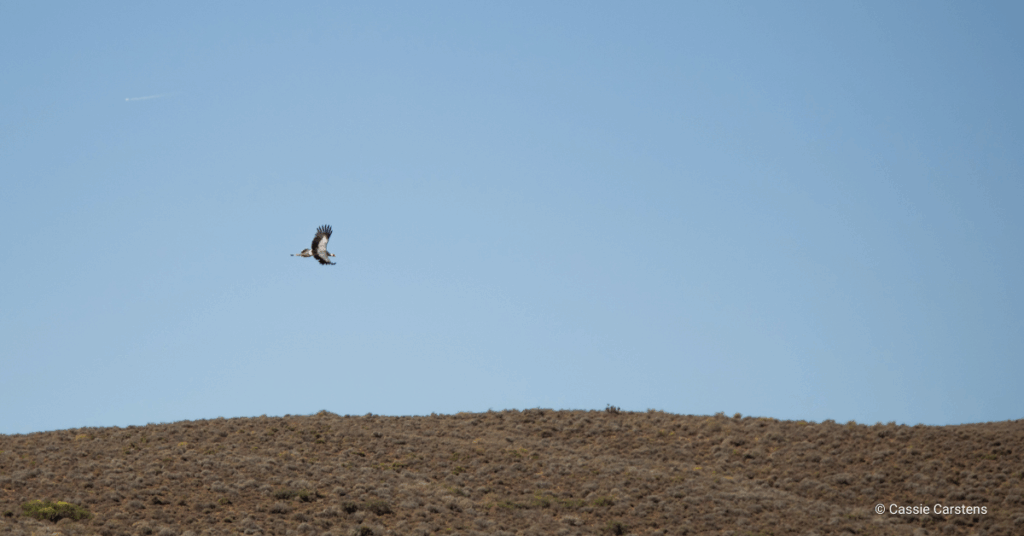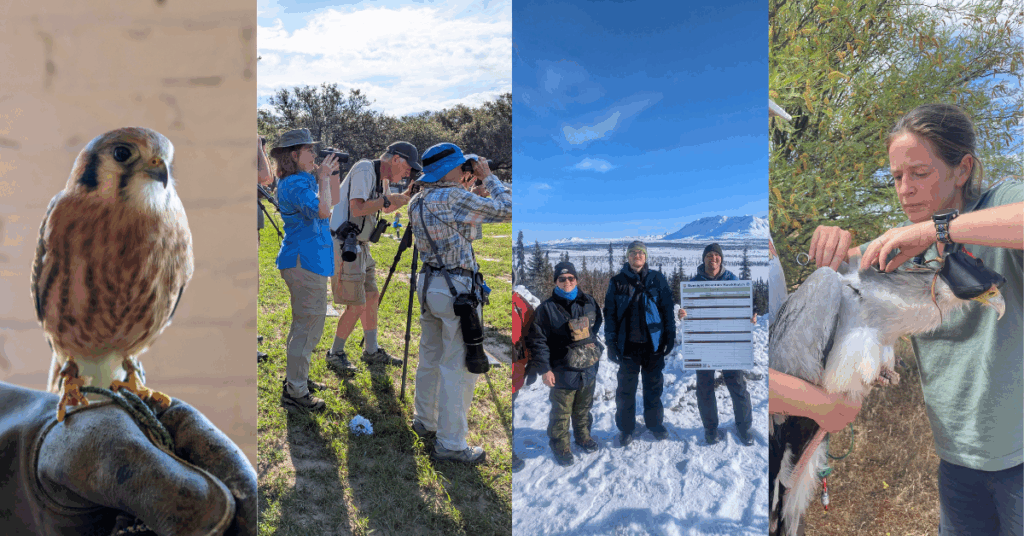Spring migration is on! So, we are going back to basics, starting at ground one for IDing raptors. The first step to identifying a raptor is deciding which family group (aka raptor type) the individual belongs to. In this blog, we will not be talking about the nitty gritty of taxonomy and the genetic links between species. Rather, we will share the commonalities that will be useful to you in the field, talking about the shared traits and behaviors we see, as well as some examples of birds in these groups. If you want to keep this information in your back pocket, you can also find it on our free Raptor ID app (Apple and Andriod).
Buteos
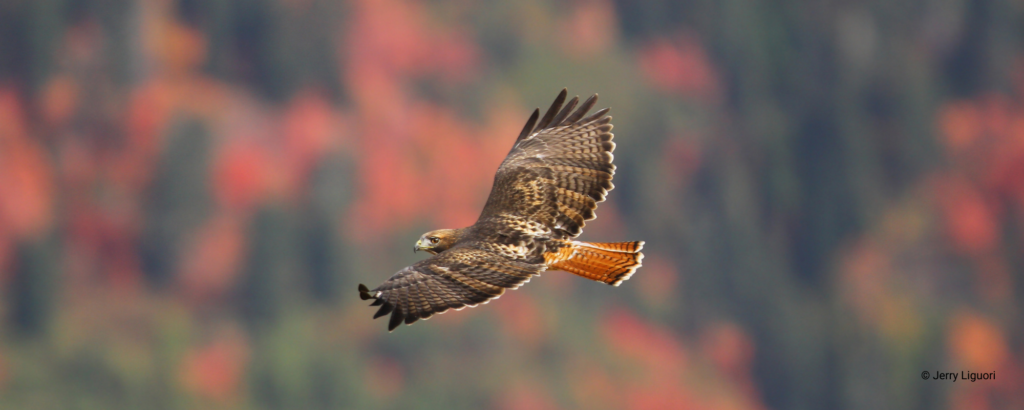
Buteos are commonly referred to as “soaring hawks.” Their wings are long but broad, and they have somewhat short tails. Some buteos are longer-winged and slimmer overall than others, and there is a significant range in size from the largest buteos to the smallest ones. Because buteos are often observed soaring overhead or perched in conspicuous places, such as the edge of a tree line or alongside a road, they are among the most familiar hawks. The Red-tailed Hawk is the most common, widespread, and well-known buteo, whereas a few species, such as the Common Black Hawk and Gray Hawk seen at the Tubac HawkWatch are range-restricted and lesser known. Some species have highly variable plumages ranging from light to dark below; some come in only one color morph. Buteos hunt in various ways, sometimes dropping to the ground from a high perch to capture prey or from high in the sky, surprising and overtaking prey from a high-speed stoop. Most buteos prey primarily on small mammals, but all will take small birds, reptiles, and even insects if the opportunity arises. Sometimes buteos are seen soaring in large flocks or “kettles” on migration, especially Broad-winged and Swainson’s Hawks. Thousands of Broad-winged Hawks can be seen at one time at a few migration sites, such as the Corpus Christi HawkWatch, in North America. Most buteos attain adult appearance in their second year, for a few, it takes a year or two longer. Buteos often seen at HWI migration sites include Broad-winged, Swainson’s, Red-tailed, Rough-legged, and Ferruginous Hawks.
Accipiters
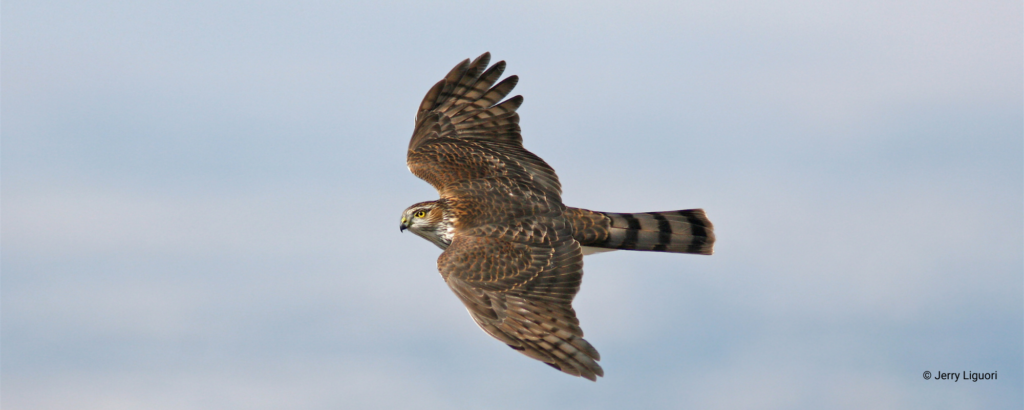
Accipiters inhabit densely forested areas (summer) or semi-open habitats (year-round). The three North American accipiters are the Sharp-shinned Hawk, Cooper’s Hawk, and American Goshawk, but it is the Cooper’s Hawk that has perfectly adapted to suburban areas, even nesting within neighborhoods and city parks. Accipiters have short, rounded wings and long, rudder-like tails, which allow them to maneuver among trees and underbrush. They are bird-eating specialists and frequent backyard bird feeders, especially Sharp-shinned and Cooper’s Hawks, who wait in hiding until the time is right for a sneak attack. All three accipiters have especially long legs and toes that assist them in grasping smaller birds in flight. Cooper’s Hawks and Goshawks are also known to prey on small mammals such as squirrels. Their recognizable flight style on migration is direct and often described as a flap-flap-glide pattern. However, they can also be seen soaring high above without a single flap during migration. As a group, accipiters are secretive and less conspicuous than buteos and other raptors. Whether perched or in flight, telling one accipiter species from another requires considerable practice using a combination of traits. All accipiters attain adult appearance in their second year.
Falcons

Falcons are exciting birds to watch. They are fast flying due to their long, narrow, pointed wings, frequently chasing down smaller birds in mid-air. They can also be seen executing vertical stoops at speeds so fast they are impossible to follow with binoculars or even the naked eye. It is said that a Peregrine Falcon can stoop at over 200 mph, making it the fastest animal on earth! There are five falcons in North America: American Kestrel, Merlin, Prairie Falcon, Peregrine Falcon, and Gyrfalcon. They range from nearly songbird size (American Kestrel) to Red-tailed Hawk size (Gyrfalcon). All North American falcons have dark brownish-black eyes and a tomial tooth (notch near the base of the upper mandible) that helps identify them. They also have “baffles” that resemble and act as a screen in their nostrils to prevent too much air from entering their system at one time when flying at high speeds. The Crested Caracara is considered a type of falcon but doesn’t look or behave like one. The Caracara has blunt-tipped wings, a long tail, bright facial skin, and inhabits a restricted southern range. They feed on carrion and are often seen with vultures.
Eagles
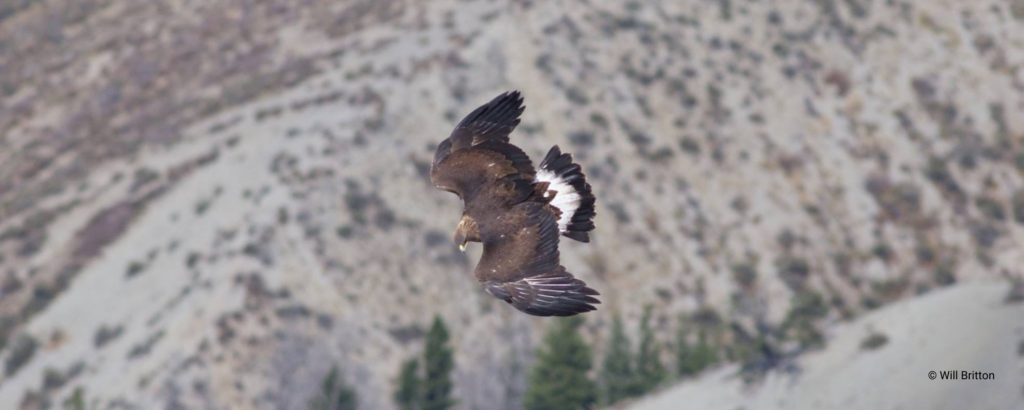
Eagles are large in size (up to 15 lbs) and extremely powerful. They have long wings (up to a seven ft wingspan) that help them soar with great ease for such a heavy weight. Studies have shown that migrant eagles can travel long distances in a single day using minimal energy. There are two eagles that inhabit North America: the Bald Eagle and Golden Eagle. Eagles can hunt a variety of prey. Bald Eagles often scavenge carcasses or steal prey from other raptors throughout the year, but they are exceptional at catching fish on their own, plucking them from the water’s surface with a quick swipe. They have also been seen snatching blackbirds from a marsh or chasing down ducks in direct flight. The bill of a Bald Eagle is prominent and powerful enough to break the skin of even the largest salmon! The Golden Eagle hunts primarily mammals and large birds but is adept at catching snakes and whatever prey catches their eye—sometimes animals as large as baby deer are part of their diet! Golden Eagles are able to stoop at speeds that rival the Peregrine Falcon! Eagles are mostly dark in color, attaining adult appearance in four to five years.
Osprey
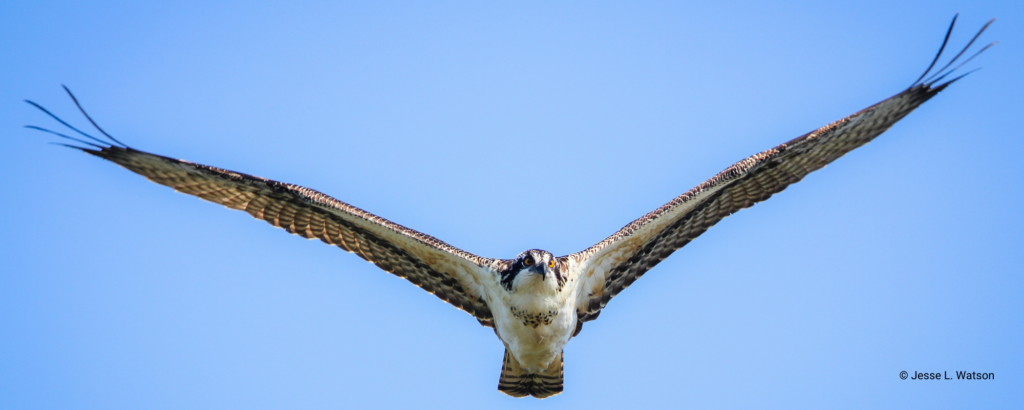
The Osprey is a large, fish-eating raptor of inland lakes, rivers, and waterways, that can be seen fishing along ocean beaches at times. They are very active hunters and exciting to watch as they hover and dive into the water repeatedly until they come up with a fish. They have sharply curved talons and small spines (called spicules) on the pads of their feet that are perfectly adapted to holding onto slippery fish. Ospreys are distinctive in appearance, with long, slim, bowed, gull-like wings and boldly patterned blackish and white undersides. Ospreys can sometimes be seen carrying fish far from water during migration—a phenomenon birders refer to as “packing a lunch.” Ospreys commonly nest on man-made structures, especially platforms and tall parking lot lights. They attain their adult appearance during their second year.
Harriers

The Northern Harrier occurs only in North America. They are easy to identify and often easy to observe but are unique in many ways. Harriers have long, narrow wings, a long tail, and a brilliant white rump that often clinches its ID. They also have a unique, owl-like facial pattern made up of stiff feathers that form a ‘facial disk.’ This helps them to hunt by sound as much as sight, sometimes in near complete darkness. Harriers are fun to watch in flight as they buoyantly teeter side-to-side over marshes and fields in search of mice and voles. Harriers perch on the ground or on low posts, unlike most raptors that perch in trees or higher surfaces. Harriers attain an adult appearance in their second year when males and females are markedly different.
Kites
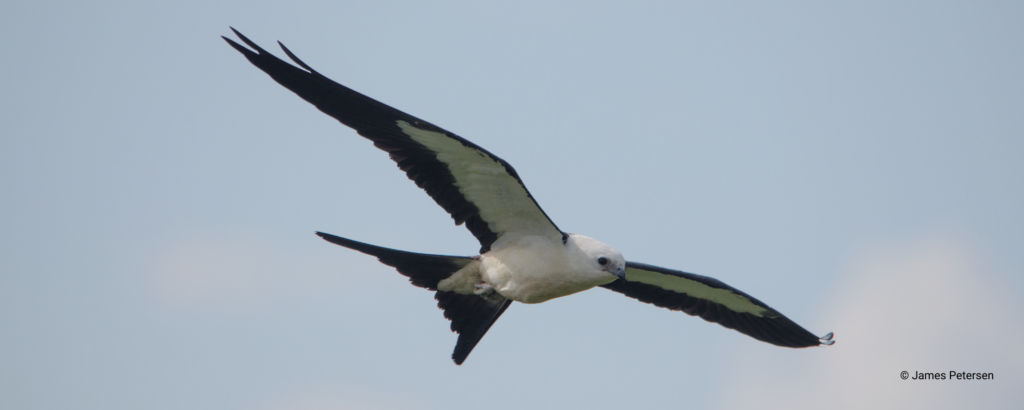
Kites are a diverse, lesser-known group of raptors that reside in warmer climates. The three North American kite species (White-tailed Kite, Mississippi Kite, and Swallow-tailed Kite) are characterized by their long, pointed wings and their aerial maneuverability. Mississippi and Swallow-tailed Kite, in particular, are masterful fliers, able to “float” in the air with ease, even on windless days. They twist and turn with a slight move of the tail or wings, and their ability to catch small prey on the wing is unmatched. The other two North American kites, Snail Kite and especially Hook-billed Kite, have paddle-shaped wings and eat mostly snails. The Snail Kite resides in parts of southern Florida, and the Hook-billed Kite is found only in south Texas within the US border but is more common in Mexico. Most kites attain an adult appearance in one to two years.
Owls
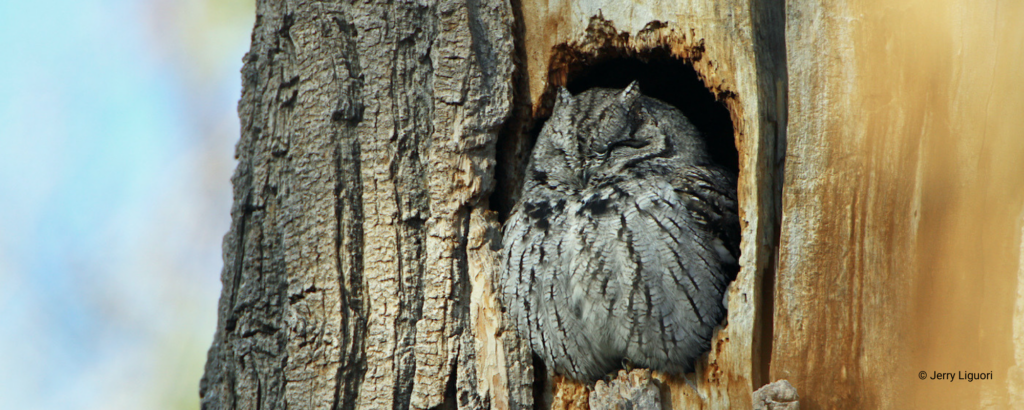
Since most owl species are nocturnal (active at night) and difficult to see, they are thought of as mysterious and regarded with superstition. Owls are not always easy to spot; they have cryptic plumage that helps them blend in with their surroundings. Owls even go undetected by other birds, but when songbirds or crows do spot an owl, they pester them every chance they get! Even though most owls hunt at night, some, such as the Northern Hawk, Burrowing, Northern Pygmy, and Snowy Owl, are active during the daytime. All owls have a defined facial disk that is distinct, and many have feathers on the top of their head called “ear tufts.” Adult and juvenile owls look similar, with some juveniles essentially identical to adults.
There are 19 species of North American owls, and the variation in size, range, behavior, and habitat between species is extensive. The Great Horned Owl is the most common, widespread, well-known, and powerful of the owls, whereas species such as the Elf Owl (smallest North American owl) and Ferruginous Pygmy Owl are range-restricted and lesser known. The preferred habitat ranges from dense forests, semi-open habitats, wide-open grasslands, suburban woodlots, parks, and golf courses, depending on geography and species. Most owls prey primarily on small mammals, but many will take small birds and reptiles, and some smaller owls feed primarily on insects. Owls, such as the Great Horned and Screech-owl, sit and wait on a perch for prey to come into view and then pounce with silent wings, taking their prey by surprise without warning. Other owls, such as the Short-eared, Flammulated, and Barn Owl, actively search for food.
Owls have powerful feet (with short toes) relative to their size. For instance, Screech-owls have been known to kill the similarly sized Sharp-shinned Hawk without a problem. Most owls have fairly short, rounded wings and short tails, but some (such as the Northern Hawk Owl) have tapered wings and long tails similar to an accipiter, which allow them to maneuver and chase songbirds. Owls are not often seen at HWI migration sites, but they are present at all of them, as documented through banding studies, satellite tracking data, and night observations! A few owls, such as the Short-eared Owl, may be seen migrating down a ridge top or soaring high above during the day, but for the most part, owls migrate during the nighttime hours.
Vultures

Vultures are large, dark birds with long, broad wings and naked heads. They are often talked about as “ugly and skittish,” but they are beautiful and graceful in flight. There are three vultures that occur in North America. The largest is the California Condor (up to a 10 ft wingspan), which is restricted in range and thought of as non-migratory. The Black Vulture is the smallest, and the Turkey Vulture is the most common and widespread. Vultures often hang out in groups, finding food and feeding together. They feed almost exclusively on dead animal carcasses (called “carrion”), which they find by sight or smell. This is thought to be somewhat unique since most birds have a very weak sense of smell. All vultures are capable of soaring for hours in search of food and fasting for several days when food is hard to find. Black and Turkey Vultures attain an adult appearance in one to two years, but Condors take at least five years.
Looking for more tips on raptor ID? Check out the rest of our Raptor Vocab 101 series, including blogs about anatomy, plumage, and aging.
This blog was written by Jerry Liguori and Brian Sullivan, with updates and additions made by HWI’s Communication Manager, Sammy Riccio. You can learn more about Sammy here.


